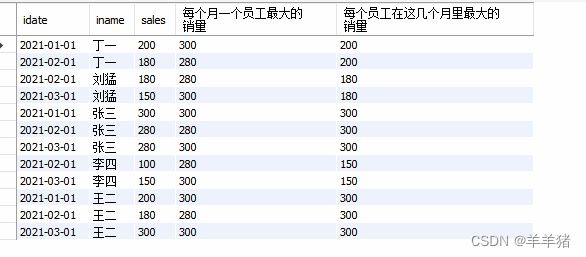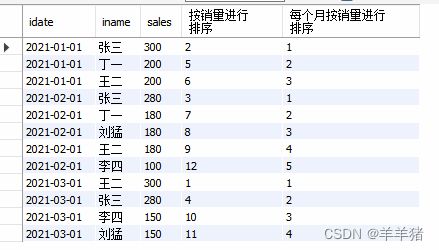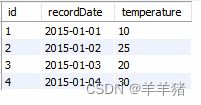SQL开窗函数之基本用法和聚合函数
开窗函数
当我们需要进行一些比较复杂的子查询时,聚合函数就会非常的麻烦,因此可以使用开窗函数进行分组再运用函数查询。窗口函数既可以显示聚集前的数据,也可以显示聚集后的数据,可以在同一行中返回基础行的列值和聚合后的结果列
开窗函数基本形式
func_name(<parameter>)
OVER(
[PARTITION BY <part_by_condition>]
[ORDER BY <order_by_list> ASC|DESC]
[rows between ?? And ??]
)
字段解释
func_name:需要进行计算的函数,在这里可以填入所需要的各种函数over():对数据进行操作partition by:根据某字段对数据进行分组order by:每个窗口的数据根据某字段进行升序或降序排列- e.g. over(partition by xxx order by yyy): 按xxx进行分组,按列yyy进行排序
rows between ... and ...:细分窗口,选择当前分区的一个子集,通常当做滑动窗口使用current row:当前行unbounded preceding:分区中的第一行unbounded following:分区中的最后一行expr preceding:(当前行 - expr的值)的行expr following:(当前行 + expr的值)的行
注:
排序子句后面缺少窗口子句,窗口规范默认是 rows between unbounded preceding and current row
排序子句和窗口子句都缺失,窗口规范默认是 rows between unbounded preceding and unbounded following
Partition by
select *,
max(sales) over(partition by idate) as '每个月一个员工最大的销量',
max(sales) over(partition by iname) as '每个员工在这几个月里最大的销量'
from Sales;
Order by
select *,
row_number() over(order by sales desc) as '按销量进行排序',
row_number() over(partition by idate order by sales desc) as '每个月按销量进行排序'
from Sales;
Rows between and
select *,
avg(temperature) over(order by recordDate rows between current row and 1 following) as '今天和明天天气的均值',
avg(temperature) over(order by recordDate rows between 1 preceding and current row) as '昨天和今天天气的均值',
avg(temperature) over(order by recordDate rows between 2 preceding and 1 preceding) as '前天和昨天天气的均值',
avg(temperature) over(order by recordDate rows between current row and unbounded following) as '今天到表里未来天气的均值',
avg(temperature) over(order by recordDate rows between unbounded preceding and current row) as '第一条记录到今天的天气均值'
from weather;
聚合函数
-- 这里举例了几个常见的聚合函数
select *,
max(sales) over(partition by month(idate)) as max,
min(sales) over(partition by month(idate)) as min,
avg(sales) over(partition by month(idate)) as avg,
sum(sales) over(partition by month(idate)) as sum
from Sales;
这里主要用到的两个例子建表如下
-- Sales表
CREATE TABLE Sales
(
idate date,
iname char(2),
sales int
);
-- 向表中插入数据
INSERT INTO Sales VALUES
('2021/1/1', '丁一', 200),
('2021/2/1', '丁一', 180),
('2021/2/1', '李四', 100),
('2021/3/1', '李四', 150),
('2021/2/1', '刘猛', 180),
('2021/3/1', '刘猛', 150),
('2021/1/1', '王二', 200),
('2021/2/1', '王二', 180),
('2021/3/1', '王二', 300),
('2021/1/1', '张三', 300),
('2021/2/1', '张三', 280),
('2021/3/1', '张三', 280);
-- weather表
drop table if exists weather;
create table weather(
id int,
recordDate date,
temperature int
);
insert into weather
values (1,'2015-01-01',10),
(2,'2015-01-02',25),
(3,'2015-01-03',20),
(4,'2015-01-04',30);
参考来源
MySQL开窗函数
MySQL模块:开窗函数
MySQL基础(六)——MySQL之开窗函数







